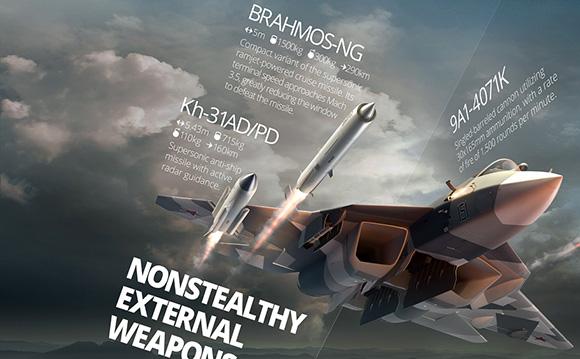The Indian version of the T-50 PAK-FA, will have to be armed with the fastest cruise missile in the world, the BrahMos. This is the new specification required for the future fifth generation fighter in development. However, to meet this demand, the T-50's internal hold will need to be modified to accommodate the missile. Finally, the design of the latter could also be revised for the new fifth generation platform. If current fighter development problems are overcome and supersonic missile deployment is successful, New Delhi may have a system that is unique in the region. The Indian Air Force could therefore deploy fifth generation platforms capable of penetrating hostile airspace and hitting, with missiles traveling at Mach 3, a series of sensitive targets.
India, thanks to the terminal phase of BrahMos deemed particularly difficult to intercept, it could hit Chinese and Pakistani targets with relative impunity. In fact, we know that Moscow and Delhi are already working on the hypersonic model BrahMos-II. The combination of a low observability platform and hypersonic missiles is considered a nightmare for a traditional defense system.
Moscow has long been engaged in the development of a special fuel that would allow hypersonic aircraft to fly at five times the speed of sound. Missiles at Mach 5 (6.125 km / h) are classified as "hypersonic". They evade detection by the enemy's air defense system, severely diminishing its ability to intercept the missile. It is therefore easy to imagine how hypersonic weapons represent the future and could drastically shift the balance of military powers in the world.
The main difficulty in developing missiles, which will fly faster than sound, is to design new materials capable of withstanding the very high temperatures caused by the hypersonic regime. We are talking, in fact, of missiles with a top speed of six / eight (or even ten / twelve) Mach with RamJet technology. The BrahMos should arm the Fifth-Generation Fighter Aircraft, fifth generation Indo-Russian fighter that gave birth to the Sukhoi T-50 PAK-FA.
The joint effort for research and development of the new fifth generation system has been revised to eight billion dollars, a budget equally divided between the two countries, compared to the initial twelve. The new agreement provides for the construction of eleven aircraft: eight in PAK-FA version for the Russians and three FGFA for the Indians with delivery of the first prototype by 2019. The contract also provides for the updating of 50 specifications, subject to cancellation of the acquisition. in the Indian Air Force of the new system, estimated at 250 aircraft.
That PAK-FA is experiencing a particularly complicated period is now well known. In six years, the six prototypes of the T-50 have completed only 700 test flights. The last known incident of a T-50 dates back to the 10 June of the 2014, when one of the two engines of the fifth prototype caught fire. Sukhoi had to suspend production of the sixth prototype and use the components already made to repair the damaged aircraft. The Indians themselves, continue to complain about serious technical shortcomings.
To date, it is unclear whether Russia has the financial means to continue supporting the development of the PAK-FA. Despite the proclamations and a series production announced in 2017, the Russian Air Force has also reduced the order of sixty T-50s to a dozen platforms with modifications implemented. Western analysts agree that when PAK-FA development is complete, Moscow will have a formidable fighter. The design is probably quite sophisticated if not similar in performance to that of the F-22 Raptor. Whether it can be even higher, this has to be proved. The Russians pay for the inexperience with the fifth generation technology, such as the integration between the different sensors and the approach with the new coating stealth of which the Pak-Fa is equipped. It could take years and billions of dollars.
 (photo: web / BrahMos Aerospace)
(photo: web / BrahMos Aerospace)












